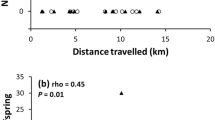Summary
Schoener (1971) proposed that the reproductive demands of animals should be important in shaping their foraging behavior because fitness is affected. He defined two forager types: energy maximizers (reproductive success depends on energetic intake) and time minimizers (reproductive success depends on time spent in activities other than foraging), and suggested that females most often illustrate the former and males the latter. We tested whether mating activities influence the foraging behavior of Uca panacea, and the predictions that females would be energy maximizers because of their reproductive strategy and that males would also be energy maximizers because of their courtship activity. Time allocated to foraging by 800 male and female fiddler crabs (at two sites) was quantified; no significant difference in foraging time was found between the sexes. Both male and female crabs allotted a large portion of their time to foraging because both sexes depend on stored energy during their reproductive bouts. Our results show that the particular forager type can be predicted based on reproductive demands, but a forager type can not always be assigned to a particular sex without consideration of all important ecological and physiological factors determining reproductive success.
Similar content being viewed by others
References
Barnwell FH, Thurman CL (1984) Taxonomy and biogeography of the fiddler crabs (Ocypodidae: Genus Uca) of the Atlantic and Gulf coasts of eastern North. Amer Zool J Linnean Soc 81:23–87
Belovsky GE (1978) Diet optimization in a generalist herbivore: the moose. Theoret Pop Biol 14:105–134
Bertness MD, Garrity SD, Levins S (1981) Predation pressure and gastropod foraging: a tropical-temperate comparison. Evol 35(5):995–1007
Charnov EL (1976) Optimal foraging: the marginal value theorem. Theoret Pop Biol 9:129–136
Christy JH (1978) Adaptive significance of reproductive cycles in the fiddler crab Uca pugilator: a hypothesis. Science 199:453–455
Christy JH (1982) Burrow structure and use in the sand fiddler crab, Uca pugilator (Bosc) Anim Behav 30(3):687–694
Christy JH (1983) Female choice in the resource-defense mating system of the sand fiddler crab, Uca pugilator. Behav Ecol Sociobiol 12:169–180
Christy JH, Salmon M (1984) Ecology and evolution of mating systems of fiddler crabs (Genus Uca) Biol Rev 59:483–509
Colby DR, Fonseca MS (1984) Population dynamics, spatial dispersion and somatic growth of the sand fiddler crab Uca pugilator. Mar Ecol Prog Ser 16:269–279
Cook RM, Cockrell BJ (1978) Predator ingestion rate and its bearing on feeding time and the theory of optimal diets. J Anim Ecol 47:529–547
Crane J (1975) Fiddler crabs of the world. Ocypodidae: Genus Uca. Princeton University Press, Princeton, New Jersey, p 736
DeCoursey PJ (1979) Egg-hatching rhythms in three species of fiddler crabs. In: Nayor E, Hartnoll RG (eds) Proceedings of the thirteenth European marine biology symposium. Pergamin Press, New York, pp 399–406
Emlen JM (1966) The role of time and energy in food preference. Amer Nat 100:611–617
Green JM, Martel G, Martin DW (1984) Comparisons of the feeding activity and diets of male and female cunners, Tautogolabrus adspersus (Pisces: Labridae) Mar Biol 84:7–11
Green JM, Martel G, Kingsland EA (1985) Foraging time allocation in territorial fish: influence of reproductive activities. Mar Ecol Prog Ser 24:23–26
Greenspan BM (1980) Male size and reproductive success in the communal courtship system of the fiddler crab Uca rapax. Anim Behav 28:387–392
Hixon MA (1982) Energy maximizers and time minimizers: theory and reality. Amer Nat 119:596–599
Hoffman SG (1983) Sex-related foraging behavior in sequentially hermaphroditic hogfishes (Bodianus spp.) Ecol 64(4):798–808
Miller DC (1961) The feeding mechanism of fiddler crabs with ecological considerations of feeding adaptations. Zool 46:89–100
Mittelbach GG (1983) Optimal foraging and growth in bluegills. Oecologia (Berlin) 59:157–162
Montague CL (1980) A natural history of temperate western Atlantic fiddler crabs (Genus Uca) with reference to their impact on the salt marsh. Contri Mar Sci 23:25–55
Pearse AS (1912) The habits of fiddler crabs. Philip J Sci (Sect D) 7:113–133
Pianka ER (1976) Natural selection of optimal reproductive tactics. Amer Zool 16:775–784
Powers LW, Cole JF (1976) Temperature variation in fiddler crab microhabitat. J Exp Mar Biol Ecol 21:141–157
Pyke HG, Pulliam HR, Charnov EL (1977) Optimal foraging: a selective review of theory and tests. Quart Rev Biol 52(2):137–154
Salmon M, Hyatt GW (1983) Spatial and temporal aspects of reproduction in North Carolina fiddler crabs (Uca pugilator). J Exp Mar Biol Ecol 70:21–43
Salmon M, Hyatt GW, McCarthy K, Costlow JD Jr (1978) Display specificity and reproductive isolation in the fiddler crabs Uca panacea and U. pugilator. Z. Tierpsychol 48:251–276
Schoener TW (1971) Theory of feeding strategies. Ann Rev Ecol Syst 11:369–404
Schoener TW (1983) Simple models of optimal feeding-territory size: a reconciliation. Amer Nat 121(5):608–629
Schwartz B, Safir SR (1915) The natural history and behavior of the fiddler crab. Cold Spring Harbor Monogr No. 8
Sih A (1982) Optimal patch use: variation in selective pressure for efficient foraging. Amer Nat 120:666–685
Smith WK, Miller PC (1973) The thermal ecology of two south Florida fiddler crabs: Uca rapax Smith and U. pugilator Bosc. Physiol Zool 46:186–207
Sokal RR, Rohlf FJ (1981) Biometry, 2nd edition. WH Freeman and Company, San Francisco
Teal JM (1958) Distribution of fiddler crabs in Georgia salt marshes Ecol 39(2):185–193
Toft CA (1984) Activity budgets in two species of bee flies (Lordotus: Bombybidae: Diptera): a comparison of species and sexes. Behav Ecol Sociobiol 14:287–296
Trivers RL (1972) Parental investment and sexual selection. In: Cambell B (ed) Sexual selection and the descent of man. Aldine Publ Co, Chicago, pp 136–179
Werner EE, Hall DJ (1974) Optimal foraging and size selection of prey by the bluegill sunfish (Lepomis mochrochirus). Ecol 55:1042–1052
Zucker N (1977) Neighbor dislodgement and burrow-filling activities by male Uca muscia terpsichores: a spacing mechanism. Mar Biol 41:281–286
Author information
Authors and Affiliations
Rights and permissions
About this article
Cite this article
Caravello, H.E., Cameron, G.N. Foraging time allocation in relation to sex by the gulf coast fiddler crab (Uca panacea). Oecologia 72, 123–126 (1987). https://doi.org/10.1007/BF00385055
Received:
Issue Date:
DOI: https://doi.org/10.1007/BF00385055




